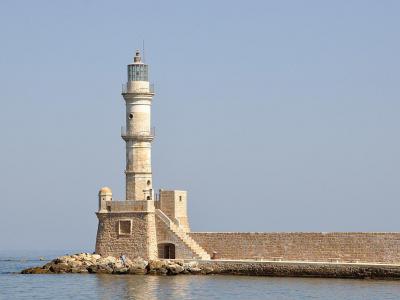Chania Lighthouse, Chania (must see)
The Lighthouse of Chania stands at the mouth of the Old Venetian Harbor, a sentinel that has seen centuries of conquest, decay, and renewal. Its story begins in the late 16th century, when the Venetians fortified the harbor as part of their defense against the advancing Ottomans. The lighthouse originally had a fortified base and was part of a system that included the Firkas Fortress on the opposite side of the harbor. A heavy chain could even be stretched across the entrance to block enemy ships, a vivid reminder of the constant threat of invasion.
Despite these efforts, the Ottoman forces seized Chania in 1645 after a brutal siege, and the once-proud Venetian lighthouse fell into neglect. For nearly two centuries, the structure crumbled, no longer serving its role as a guardian for sailors. Its revival came between 1824 and 1832, when Crete fell under Egyptian administration. Rebuilt in a minaret-like style, the lighthouse took on its distinctive shape that still captures attention today. Locals often refer to it as the “Egyptian Lighthouse,” a nod to the period when Egypt briefly held sway over Crete on behalf of the Ottoman Empire.
The lighthouse endured its share of hardships in modern times as well. Bombings during World War II and earthquakes weakened the structure, leaving it scarred but not broken. A major renovation in 2005 ensured its survival, restoring its domed tower and securing its place as one of Chania’s most iconic landmarks.
Today, the lighthouse is no longer used for navigation but remains deeply woven into the identity of the city. The long mole leading out to it has become a favorite promenade for locals and visitors alike, especially at sunset when the tower casts its silhouette across the sea. For those who walk its length, the lighthouse offers more than a view-it is a connection to Chania’s layered past, a reminder of fleets, battles, and the enduring relationship between the city and the sea.
Despite these efforts, the Ottoman forces seized Chania in 1645 after a brutal siege, and the once-proud Venetian lighthouse fell into neglect. For nearly two centuries, the structure crumbled, no longer serving its role as a guardian for sailors. Its revival came between 1824 and 1832, when Crete fell under Egyptian administration. Rebuilt in a minaret-like style, the lighthouse took on its distinctive shape that still captures attention today. Locals often refer to it as the “Egyptian Lighthouse,” a nod to the period when Egypt briefly held sway over Crete on behalf of the Ottoman Empire.
The lighthouse endured its share of hardships in modern times as well. Bombings during World War II and earthquakes weakened the structure, leaving it scarred but not broken. A major renovation in 2005 ensured its survival, restoring its domed tower and securing its place as one of Chania’s most iconic landmarks.
Today, the lighthouse is no longer used for navigation but remains deeply woven into the identity of the city. The long mole leading out to it has become a favorite promenade for locals and visitors alike, especially at sunset when the tower casts its silhouette across the sea. For those who walk its length, the lighthouse offers more than a view-it is a connection to Chania’s layered past, a reminder of fleets, battles, and the enduring relationship between the city and the sea.
Want to visit this sight? Check out these Self-Guided Walking Tours in Chania. Alternatively, you can download the mobile app "GPSmyCity: Walks in 1K+ Cities" from Apple App Store or Google Play Store. The app turns your mobile device to a personal tour guide and it works offline, so no data plan is needed when traveling abroad.
Chania Lighthouse on Map
Sight Name: Chania Lighthouse
Sight Location: Chania, Greece (See walking tours in Chania)
Sight Type: Attraction/Landmark
Guide(s) Containing This Sight:
Sight Location: Chania, Greece (See walking tours in Chania)
Sight Type: Attraction/Landmark
Guide(s) Containing This Sight:
Walking Tours in Chania, Greece
Create Your Own Walk in Chania
Creating your own self-guided walk in Chania is easy and fun. Choose the city attractions that you want to see and a walk route map will be created just for you. You can even set your hotel as the start point of the walk.
Chania Introduction Walking Tour
Nineteenth-century English traveler Robert Pashley swore Chania “will repay the traveler a hundredfold.” The story of Chania stretches deep into antiquity. Its earliest name, Kydonia, appears in the epic works of Greek poet Homer and is thought to derive from the quince fruit that once grew in abundance here. Archaeological evidence shows that as early as the 14th century BC, the Minoans built... view more
Tour Duration: 2 Hour(s)
Travel Distance: 3.2 Km or 2 Miles
Tour Duration: 2 Hour(s)
Travel Distance: 3.2 Km or 2 Miles




